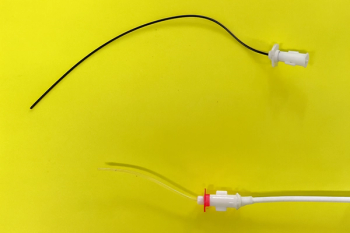
Advanced interpretation of the urine sediment (Proceedings)
Urine sediment examination is an essential part of the urinalysis. As discussed in the previous lecture, a urinalysis should be performed whenever blood is collected for a 'metabolic screen' or 'healthy animal exam,' or a clinician is investigating any systemic disease.
Urine sediment examination is an essential part of the urinalysis. As discussed in the previous lecture, a urinalysis should be performed whenever blood is collected for a 'metabolic screen' or 'healthy animal exam,' or a clinician is investigating any systemic disease. Urinalysis can also be an essential part of monitoring specific diseases or therapies, such as with diabetes mellitus or administration of some antibiotics. Familiarity with how various diseases can affect the urinalysis and how to further work-up urinalysis abnormalities are necessary for a proper appreciation of this diagnostic test.
To prepare urine sediment for examination, 5 ml of urine should be centrifuged at low speed (1000-1500 rpm for 5 minutes). Do not brake or manually slow down the centrifuge as the resulting turbulence may resuspend the sediment. Remove all but the bottom 0.5 ml of fluid, and then resuspend the pellet with a gentle tap. Place one drop on a slide, and then place a coverslip. The 10X objective should be used for casts, and the 40X objective for the rest of the examination. Examine at least 10 fields, and average the number of cells, casts, etc. seen per field.
Without question the most important tools for conducting a thorough urine sediment examination are a high quality, well-maintained microscope, and a good reference book with plenty of pictures that can be used for comparison of findings. Although there are many options available, I have found Osborne's
Urinalysis: A Clinical Guide to Compassionate Patient Care (CA Osborne and Stevens JB. Shawnee Mission, KS; Bayer Corporation, 2003) to be the most user-friendly and versatile option.
Crystalluria: There are many types of crystals that may be found in urine, and discussion of all these types is beyond the scope of this presentation. However, the most common mistakes made are assuming that the presence of crystals is synonymous with disease and requires intervention, that the absence of crystals implies absence of uroliths, and not realizing that crystals can form AFTER collection of urine, particularly if urine temperature decreases significantly before urine sediment examination.
Struvite crystalluria is a common finding in healthy dogs and cats. Unlike uroliths, when struvite crystals occur without uroliths they are RARELY associated with urease-producing bacterial urinary tract infections. Greater than 50% of healthy dogs will have struvite crystals incidentally noted on urinalysis. This likely occurs because the various components of these crystals (magnesium, ammonia, phosphate) are normally excreted in large amounts; supersaturation is therefore common. In the absence of clinical signs of lower urinary tract disease, urine culture can be considered in animals with a history of bacterial urinary tract infections or with concurrent diseases that predispose to urinary tract infections. Intervention in the absence of confirmed urinary tract infection should be considered when large numbers of crystals are present in male cats with a history of obstruction, or patients with a history of sterile struvite urolithiasis. Preventative therapy should focus on decreasing urine specific gravity above all else; acidifying urine pH is also beneficial.
Calcium oxalate crystalluria is also a common, incidental finding in healthy dogs and cats. As such, most animals do not require intervention to prevent or reduce formation. In some cases calcium oxalate monohydrate crystalluria may be associated with ethylene glycol ingestion, diseases that cause hypercalcemia or promote calcium excretion (e.g. hyperparathyroidism), and may be of concern in breeds that are predisposed to formation of calcium oxalate uroliths. In asymptomatic animals the first step is usually to confirm that crystals are a repeatable finding. In the absence of clinical signs, tests to consider are a full minimum database, particularly serum calcium, BUN, and creatinine. Intervention may be considered when large numbers of crystals are present in a breed that is predisposed to urolith formation (Maltese, Bichon Frise, etc.), and should definitely be instituted in animals with a history of calcium oxalate urolithiasis. Therapy is the same as for calcium oxalate urolith prevention. More detail on management of crystalluria is presented in the lecture 'Stones vs. Crystals: Management vs. Prevention.'
Urate crystals may be uric acid, sodium urate, or ammonium urate. Unlike struvite and calcium oxalate, uric acid crystals are not a normal or incidental findings on urinalysis. Urine supersaturation and crystal formation may occur with impaired hepatic handling of uric acid and ammonia (animals with hepatic disease, particularly portosystemic shunts), or in animals with metabolic errors. Breeds with known increased risk of abnormal urate handling include Dalmatians and English Bulldogs. Asymptomatic urate crystalluria should be followed by a full minimum data base to screen for possible hepatic dysfunction, and a liver challenge test (serum bile acids or ammonia tolerance) if needed. The primary disease should be treated in those animals with confirmed hepatic dysfunction; specific therapy to decrease crystalluria is not always needed. Intervention in patients with errors of metabolism and without a history of urolith formation should be considered in males (females rarely develop urinary tract obstruction secondary to urolithiasis). Intervention should also be considered in young animals; animals greater than 6-8 years of age at the time that urate crystals are first diagnosed are less likely to progress from urate crystal formers to urate urolith formers. Therapy for urate crystal prevention is the same as for urolith prevention.
Casts: Casts are formed when macromolecules are trapped within a protein matrix in the renal tubules, forming cylinders of various width and length, and eventually passing into the urine. Because protein and mucous are normally produced by the tubules, casts can be a normal finding.
Hyaline casts are formed of mucous and protein; these casts are the predominant type seen in normal urine sediment. However, when proteinuria is present, an increase in filtered protein may cause an increase in hyaline casts. Epithelial, coarse granular, fine granular, and waxy casts are thought to represent different stages of renal tubular injury. Injury to the kidneys (toxic, ischemic, or other) causes epithelial cells from the tubules to slough and become trapped in the normal protein and mucous, forming epithelial casts. With time these cells may degenerate, forming intracellular granules; eventually, coarse and then fine granular casts remain. Further degeneration leads to waxy casts. Unfortunately, the absence of these casts does not mean that ongoing renal injury is not occurring. Conversely, because casts may become trapped within the renal tubules and only pass into the urine intermittently it is difficult to gauge the time course of injury based on the predominant cast type. In short, the presence of many casts should be investigated further, but other than being a warning of possible kidney damage, serial examination of urine for casts is not indicated for gauging efficacy of therapy or disease progression.
Leukocytes: White blood cells can be found in urine with ANY cause of urinary tract inflammation, including uroliths and neoplasia. In other words, pyuria is not synonymous with urinary tract infection. If infection is suspected then a urine culture should be submitted; trial courses of antibiotics are rarely if ever indicated. Some leukocytes are expected in urine, particularly in voided and catheterized samples, because the urethra and external genitalia are not completely sterile. However, the presence of white blood cells within casts is pathognomonic for pyelonephritis. The presence of white blood cells other than neutrophils in urine sediment is rare. However lymphocytes and lymphoblasts are occasionally found in the urine of dogs with lymphoma.
Erythrocytes: Dipsticks will indicate hematuria when red blood cells, hemoglobin, or myoglobin are present in urine; differentiation of these three possibilities is the first step when faced with hematuria. Centrifugation of urine should cause all red blood cells to form a pellet. If red blood cells are present, measuring the PCV of the urine (in addition to the serum) can help with diagnostic and therapeutic decisions. Be warned—urine can appear VERY bloody and still have a very low PCV, so do not immediately panic when gross hematuria is present. Red blood cells lyse more quickly in dilute or alkaline urine, so if hematuria due to intact red blood cells is suspected, examination of urine soon after collection is recommended.
Epithelial cells: Cells that originate from any portion of the urinary tract can normally be found in small numbers in the urinary tract. Although these cells have subtle differences that may allow differentiation of their site of origin, this is rarely easily done or useful. Epithelial cells may increase with inflammation of any cause, and large numbers of epithelial cells are occasionally found in normal animals. Transitional cell carcinoma cells are the other differential to consider when epithelial cells are noted in urine sediment. Unfortunately concurrent inflammation, particularly due to bacterial urinary tract infections, may cause criteria of malignancy in bladder epithelial cells, therefore always interpret the presence of 'neoplastic' cells in the context of concurrent sediment findings, including number of leukocytes and presence of bacteria. If diagnostic imaging fails to reveal an obvious mass within the bladder, then treatment of possible infection is recommended, followed by repeat sediment examination.
Lipid: Lipid droplets are often found in the urine of normal cats; the reason for their formation is unknown. Lipid in the urine of dogs is much rarer, but is more commonly associated with pathologic conditions than in cats. Diseases to consider in dogs are those that lead to high serum cholesterol and triglycerides, including diabetes mellitus, hyperadrenocorticism, and hypothyroidism; urine lipid may also increase post-prandially.
Bacteria: Visualization of bacteria on urine sediment examination should be followed by culture of a sterile urine sample. However, the presence of bacteria is not synonymous with infection, because the distal urethra is not sterile in dogs and cats. Bacteria may also be an artifact introduced by passage of the cystocentesis needle through a bowel loop. Finally, many bacteria that are visualized in unstained urine sediment are actually incidental stain debris and not true bacteria. The sensitivity and specificity of identification of bacteria in unstained urine sediment are 82.4% and 76.4%, respectively. In other words, a significant number of infections are missed, and about 25% of bacteria seen are actually NOT bacteria. In contrast, if urine sediment is stained with a standard modified Wright stain then sensitivity and specificity both increase greatly (93.2%, and 99.0%)
Other organisms: Non-bacterial organisms, such as fungi, algae, yeast, and parasites, can occasionally be found on urine sediment examination. Urine should be submitted for fungal culture whenever fungal elements are noted, or when systemic fungal disease is suspected. Because organisms and cells may degrade over time, it may also be useful to prepare some slides in the clinic, air-dry them, and submit to a laboratory along with unprocessed urine for cytological examination.
Newsletter
From exam room tips to practice management insights, get trusted veterinary news delivered straight to your inbox—subscribe to dvm360.





